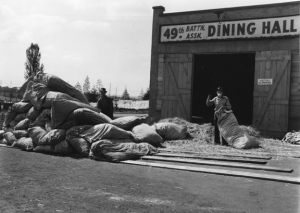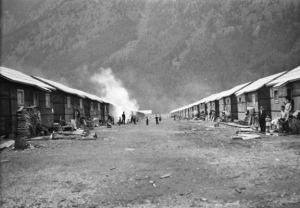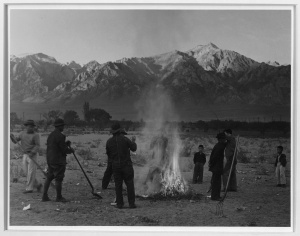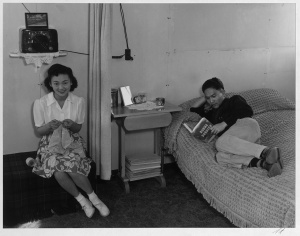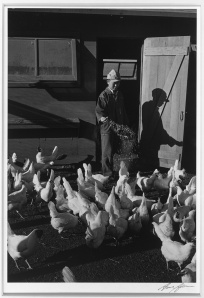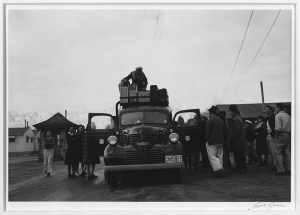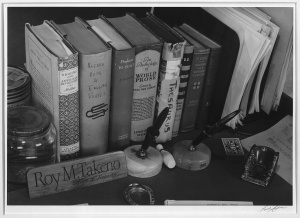On the way in to work this week, I just happened to notice an exhibition on display at the Pendulum Gallery in Vancouver and upon finding out that the exhibition closes on May 3, 2014, I decided to stop and take it in on the way home. Both photographers’ collections are in the public domain and I have included a few of their images in my review.
The Two Views Exhibition is a selection of photographs by Ansel Adams (no introduction needed) and Leonard Frank, a Canadian photographer and is a traveling exhibition from the Nikkei National Museum, Burnaby, British Columbia. It showcases thought provoking images of the Japanese who were placed in internment camps in the United States and Canada during World War II.
After Japan attacked Pearl Harbour in 1941 the United States and Canadian governments relocated Japanese citizens from the coastal regions of western North America, moving them to the interior. Approximately 22,000 Japanese Canadians and 120,000 Japanese Americans were displaced. The Nikkei Museum’s presentation of this exhibition coincides with the twenty fifth anniversary of the 1988 official apologies by the United States and Canada for the treatment of Japanese people during and after the war.
There were only about 17 photographs from Ansel Adams collection on the Manzanar Relocation Center, but I went online when I returned home and checked out his full collection on the Library of Congress’s website.
I had never heard of Leonard Frank, so also went online to do a bit of research about him and found out that he was a local Vancouver photographer who did a lot of work similar to that done by Walker Evans and Dorothea Lange during the Farm Security Administration. Frank, however, tended to document logging camps, industries and it would also seem that he has documented almost every street in early Vancouver as well.
It is clear that the two photographers approached their projects in very different ways. Frank has taken a very clinical approach to his presentation. His photos are stark and impersonal. Not many people actually feature in his photos and those that do all seem to display deadpan expressions: his collection seems more to be about the living arrangements or places than the actual people and this is reflected in the title of each of his photos as can be seen below (Building A…, Building B…, Tashme, BC …, etc). The Japanese Canadians were only given between 24 – 48 hours to evacuate their homes and then they were taken to one of the clearing sites (Hastings Park in this instance) where they were detained until internment camps were made for them. A very stressful situation indeed!
The starkness of Frank’s photos are emphasized by the overwhelming brightness of the lights in the dormitory and baggage room as can be seen in Fig 01 and Fig 03 and to a certain extent in Fig 04.
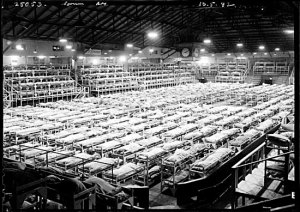
Fig 01: Frank, Leonard: Building K, Men’s Dormitory – (Formerly Forum); Hastings Park, Vancouver, BC

Fig 03: Frank, Leonard: Building B”, Baggage Room – (Formerly Horse Show Building)”; Hastings Park, Vancouver, BC
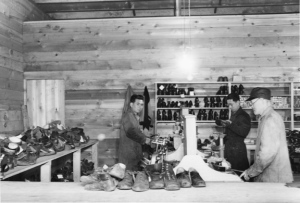
Fig 04: Frank, Leonard: Building D – Shoe Repair Shop – (Formerly Church Dining Hall); Hastings Park, Vancouver, BC
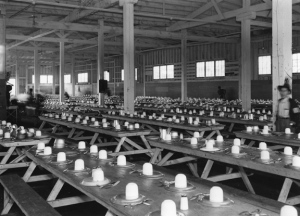
Fig 05: Frank, Leonard: Building E”, Men’s Dining Room – (Formerly Industrial Building); Hastings Park, Vancouver, BC
Figures 1 through 5 are of the clearing site, Hastings Park in Vancouver, while figure 6 is taken of one of the internment camps in the interior of British Columbia.
In contrast to this, Ansel Adams has treated many of his photographs as he would his renowned landscapes. There is a softness and beauty present in his images even though the subject matter of the collection is about war internment. In viewing this exhibition and looking at more of his collection online, it is clear that he took the time to get to know his subjects. He did individual portraits of his subjects and they are for the most part relaxed and smiling. The people are all engaged in various activities. He also portraits family life in the internment camps.
Adams gives us the perfect examples of balance in images. In figure 07 he makes use of dynamic balance. The sign to the camp is front and foremost and almost to the edge of the frame while the (guard?) hut in the distance provides the balance to this image. The two forms providing the balance are dark in tone, while the mountains and clouds in the distance provide a softening and calming effect to the image. Where it not for the words on the sign, one could almost think that this was the entrance to a farm or holiday camp.
In figure 08 Adams again uses dark foreground tones, this time in the people standing around the fire. The people are standing in a circle around the fire and the balance is centre-weighted.
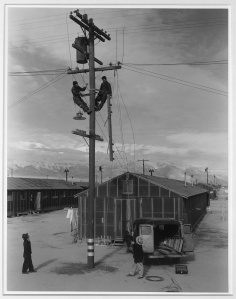
Fig 09: Adams, Ansel 1943: Line crew at work in Manzanar, Manzanar Relocation Center, Manzanar, California
There is almost a sense of humour in the balance in figure 09. Although the pole is slightly off centre, it is compensated by the two men working on the pole. Their body angles are almost mirror images, while down below on the ground, the image is anchored by the two individuals looking up at the pole workers. The diagonal cables just above the pole workers’ heads also lend balance to the image.
Figure 10 is a good example of bilateral symmetry. The little table between Mr and Mrs Shimizu acts as the fulcrum point balancing the two individuals in the image.
The diagonal shadows and diagonal door strut all quickly draw one’s attention to Mori Nakashima in figure 11. The white chickens in the foreground provide a visual weight to the image.
Once again another example of bilateral symmetry in figure 12. The car is placed centre of frame with both its doors open, providing another level of balance. This theme is continued by the people congregated on either side of the vehicle. The man on top of the car’s roof serves to draw the immediate attention to the car.
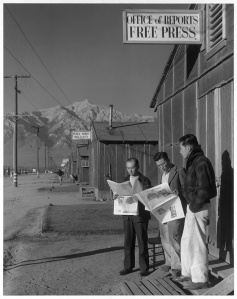
Fig 13: Adams, Ansel 1943: Roy Takeno, editor, and group reading paper in front of office, Manzanar Relocation Center, California
Summary: Roy Takeno (far left), with Yuichi Hirata and Nabou Samamura, standing in front of the Office of Reports Free Press. Two men are reading the Los Angeles Times newspaper.
In figure 13 Adams makes use of convergent lines to achieve his balance. On the right side of the frame are the building structures, on the left the telephone poles and wires which seem to converge in the far distance. The photo is further balanced by the group of men on frame right (this grouping is in itself a sub grouping as one could group the two men reading the newspaper together against the one who is just standing watching them and is a good example of the Gestalt Law of Similiarity). The Free Press sign overhead provides a further balancing point to the image, emphasizing the dynamic balance.
The final image is a photograph of Roy Takeno’s desk. I find this image touching and extremely personal. The contents of the desk tell us a lot about the man. That he had a copy of “A Handbook for Newspaper Workers” is evident that he was a reporter. He was interested in his country’s history (“Origins of the American Revolution”) however, we don’t know if he was a Japanese immigrant or born in the USA. He was also interested in politics (“US Foreign Policy”), but above all, I get the impression he was a peaceful, calm and introspective person (“Oxford Book of English Verses”, “Prefaces to Peace”, “An Anthology of Word Prose”). He also smoked (matches) and was maybe a little superstitious (horseshoe), but a tad sentimental too (the skittle).
It is also interesting to note that Adams regarded his Manzanar Collection as “…from a social point of view that’s the most important thing I’ve done or can do, as far as I know.” (National Park Service, Manzanar National Historic Site, Ansel Adams Gallery. [online] Available from: http://www.nps.gov/manz/photosmultimedia/ansel-adams-gallery.htm [Accessed 6 May, 2014]
This exhibition certainly lived up to its title, “Two Views”. Even though Ansel Adams photographs are of a superior quality to those of Leonard Frank, I find that Frank’s images resonate more with me. This is probably attributable to the fact that I have actually been in those buildings which have all reverted to their initial purposes again, namely for agricultural, industrial and entertainment shows, with an amusement park on the side. I don’t think I shall ever set foot in any of those buildings again without thinking of the people who were interned there and endured such hardship and whose civil liberties were stripped away from them overnight.
Bibliography
Harding, Jon. Hastings Park Internment Centre. Vancouvertraces [online]. Available from: http://vancouvertraces.weebly.com/hastings-park-internment-centre.html [Accessed 6 May, 2014]
Japanese Canadian Internment. Wikipaedia [online]. Available from: http://en.wikipedia.org/wiki/Japanese_Canadian_internment [Accessed 3 May, 2014]
National Park Service, Manzanar National Historic Site, Ansel Adams Gallery. [online] Available from: http://www.nps.gov/manz/photosmultimedia/ansel-adams-gallery.htm [Accessed 6 May, 2014]
Nikkei National Museum. Alex Eastwood Collection. [online]. Available from: http://nikkeimuseum.org/www/collections_detail.php?col_id=F5 [Accessed 2 May, 2014]
Figure 01
Frank, Leonard. (circa 1942). Building K, Men’s Dormitory – (Formerly Forum); Hastings Park, Vancouver, BC. [online image]. Part of the Alex Eastwood Collection, Nikkei National Museum, . [Number 1994.69.3.18]. Available from http://nikkeimuseum.org/www/item_detail.php?art_id=A2221 [Accessed 2 May, 2014]
Figure 02
Frank, Leonard. (circa 1942). Filling Palliasses – Hastings Park; Hastings Park, Vancouver, BC. [online image]. Part of the Alex Eastwood Collection, Nikkei National Museum. [Number 1994.69.3.29]. Available from http://nikkeimuseum.org/www/item_detail.php?art_id=A2245 [Accessed 2 May, 2014]
Figure 03
Frank, Leonard. (circa 1942). Building B”, Baggage Room – (Formerly Horse Show Building)”; Hastings Park, Vancouver, BC. [online image]. Part of the Alex Eastwood Collection, Nikkei National Museum. [Number 1994.69.3.26]. Available from http://nikkeimuseum.org/www/item_detail.php?art_id=A2243 [Accessed 2 May, 2014]
Figure 04
Frank, Leonard. (circa 1942). Building D – Shoe Repair Shop – (Formerly Church Dining Hall); Hastings Park, Vancouver, BC. [online image]. Part of the Alex Eastwood Collection, Nikkei National Museum. [Number 1994.69.3.30]. Available from http://nikkeimuseum.org/www/item_detail.php?art_id=A2246 [Accessed 2 May, 2014]
Figure 05
Frank, Leonard. (circa 1942). Building E”, Men’s Dining Room – (Formerly Industrial Building); Hastings Park, Vancouver, BC. [online image]. Part of the Alex Eastwood Collection, Nikkei National Museum. [Number 1994.69.3.14]. Available from http://nikkeimuseum.org/www/item_detail.php?art_id=A2236 [Accessed 2 May, 2014]
Figure 06
Frank, Leonard. (circa 1942). Tashme, BC. [online image]. Part of the Alex Eastwood Collection, Nikkei National Museum. [Number 1994.69.4.27]. Available from http://nikkeimuseum.org/www/item_detail.php?art_id=A2218 [Accessed 2 May, 2014]
Figure 07
Adams, Ansel (1943). Entrance to Manzanar, Manzanar Relocation Center. [online image]. Library of Congress Prints and Photographs Division Washington, D.C. 20540 USA. Reproduction Number: LC-DIG-ppprs-00286 (b&w digital file from original print). Available from: http://www.loc.gov/pictures/item/2002695960/ [Accessed 2 May, 2014]
Figure 08
Adams, Ansel (1943). Burning leaves, autumn dawn, Manzanar Relocation Center, California. [online image]. Library of Congress Prints and Photographs Division Washington, D.C. 20540 USA. Reproduction Number: LC-DIG-ppprs-00308 (b&w digital file from original print). Available from: http://www.loc.gov/pictures/item/2002695133/ [Access 2 May, 2014]
Figure 09
Adams, Ansel (1943).Line crew at work in Manzanar, Manzanar Relocation Center, Manzanar, California. [online image]. Library of Congress Prints and Photographs Division Washington, D.C. 20540 USA.Reproduction Number: LC-DIG-ppprs-00296 (b&w digital file from original print). Available from: http://www.loc.gov/pictures/item/2002695134/ [Accessed 2 May 2014]
Figure 10
Adams, Ansel (1943). Mr. and Mrs. Dennis Shimizu. [online image.] Library of Congress Prints and Photographs Division Washington, D.C. 20540 USA. Reproduction Number: LC-DIG-ppprs-00401 (b&w digital file from original print). Available from: http://www.loc.gov/pictures/item/2002695327/ [Accessed 2 May, 2014]
Figure 11
Adams, Ansel (1943). Poultry farm, Mori Nakashima, Manzanar Relocation Center. [online image]. Library of Congress Prints and Photographs Division Washington, D.C. 20540 USA. Reproduction Number: LC-DIG-ppprs-00331 (b&w digital file from original print). Available from: http://www.loc.gov/pictures/item/2002696009/ [Accessed 2 May, 2014]
Figure 12
Adams, Ansel (1943). Relocation: Packing up, Manzanar Relocation Center. [online image]. Library of Congress Prints and Photographs Division Washington, D.C. 20540 USA. Reproduction Number: LC-DIG-ppprs-00294 (b&w digital file from original print). Available from: http://www.loc.gov/pictures/item/2002695977/ [Accessed 2 May, 2014]
Figure 13
Adams, Ansel (1943). Roy Takeno, editor, and group reading paper in front of office, Manzanar Relocation Center, California. [online image]. Library of Congress Prints and Photographs Division Washington, D.C. 20540 USA. Reproduction Number: LC-DIG-ppprs-00363 (b&w digital file from original print). Available from: http://www.loc.gov/pictures/item/2002696017/ [Accessed 2 May, 2014]
Figure 14
Adams, Ansel 1943). Roy Takeno’s desk, Manzanar Relocation Center. [online image]. Library of Congress Prints and Photographs Division Washington, D.C. 20540 USA.Reproduction Number: LC-DIG-ppprs-00277 (b&w digital file from original print). Available from: http://www.loc.gov/pictures/item/2002695979/ [Accessed 2 May, 2014]

